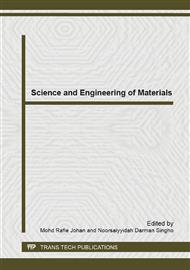p.3
p.7
p.12
p.16
p.20
p.29
p.35
p.39
The Effects of YSZ-Al2O3 Addition on Hydroxyapatite Fabricted by Powder Metallurgy
Abstract:
Yttria-stabilized zirconia (YSZ) becomes popular alternative to alumina (Al2O3) especially for hard tissue applications. Both zirconia and alumina own their good biocompatibility due to chemical inertness in body environment. Considering the bioactive of hydroxyapatite (HAP) will allow interfacial bond formation, it is desirable to combine the advantages of both materials, YSZ and Al2O3 with HAP. Various amounts (30, 40, 50, 60 wt. % of YSZ-Al2O3)/10HAP of composites have been prepared by powder metallurgy method. Several tests have been conducted to determine the effect YSZ addition on physical, mechanical properties and the microstructure of composites. The results showed that density and compressive strength increased with increasing wt. % of YSZ. Microstructural characterization has been observed by scanning electron microscope (SEM) showed the presence of pores reduced slightly in increasing of wt. % of YSZ. The prepared YSZ-Al2O3/10HAP composite is expected as a potential candidate for biomedical application.
Info:
Periodical:
Pages:
12-15
Citation:
Online since:
June 2014
Price:
Сopyright:
© 2014 Trans Tech Publications Ltd. All Rights Reserved
Share:
Citation:


